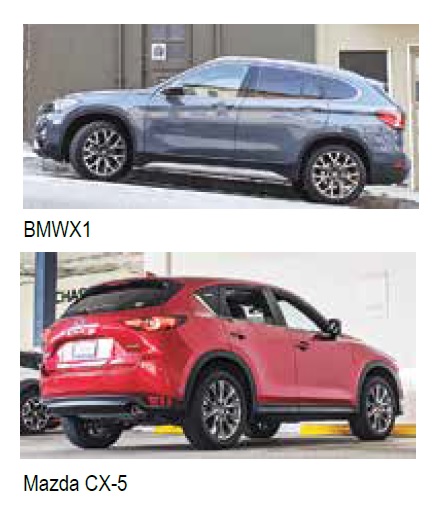
By Philip Ruth–
Back to cars! That’s what the Bay Area is bracing for—an en masse migration from transit and rideshare services to private automotive travel. With post-coronavirus normality projected out somewhere in late 2021 or after, one feature of our near future will be a lot of sitting in traffic.
We’re all adjusting to new realities these days, and so an already-bad problem made worse is just another headline that scrolls past on our way to the updated virus death count. But if you’re forced back into owning a car, my anchor advice is more important than ever: get something you really, truly like.
It doesn’t matter if your budget is $850 or 100 times that; you will likely be passing much time in your new rig, and a thoughtfully designed vehicle that is engaging to drive can make each day a bit brighter.
I experienced those brighter days when evaluating this week’s compact crossovers, the BMW X1 and Mazda CX-5. BMW and Mazda both focus on fun behind the wheel, albeit at different price points: the base X1 is almost exactly $10,000 above the entry-level CX-5, which checks in at $25,190.

Options on both held that gap in the pressers I drove, with the CX-5 Signature AWD at $38,820, and the X1 xDrive28i at $48,645.
So, what does that $10,000 buy? For some, the status of a BMW nameplate justifies it. Mazda isn’t far behind, as one onlooker commented that the CX-5 had the presence of an upscale brand. I found both to be handsome in their own ways. The BMW looks beefy and athletic with its $1,200 “Storm Bay Metallic” finish, while the CX-5 has a smooth elegance about it, accented by its luminous, $595 “Soul Red” crystal paint.
That’s how they drive, too. The BMW tingles with good vibes through the steering wheel, with more communication than most. The Mazda’s controls respond more softly to the touch, but your commands are still met with pleasing immediacy. Both ride on 19-inch aluminum wheels, and both feel planted and eager to play.
The BMW’s turbocharged engine gives it a clear advantage; the stated curb weights are within 13 pounds of each other, yet at 228 horsepower, the BMW has 41 more horses under the hood. And if you can keep your foot out of it—not an easy task, as the BMW feels better the faster it goes—you’ll also benefit from EPA combined ratings that give the BMW’s 26 mpg a two-mpg plus over the Mazda’s.
Inside, the BMW’s $400 sport seats had firm cushions, while the Mazda’s padding was more compliant. Both had uncommonly substantial thigh support, a make-or-break aspect for taller drivers.
Looping back to the traffic congestion we’re facing, perhaps the most important feature on each was automatic cruise control, with stop and go. It’s standard on the CX-5 Signature and a $1,000 option on the X1 xDrive28i, and it’s a huge stress reliever when you’re inching along the highway.
Philip Ruth is a Castro-based automotive photojournalist and consultant with an automotive staging service.
Published on June 11, 2020
Recent Comments